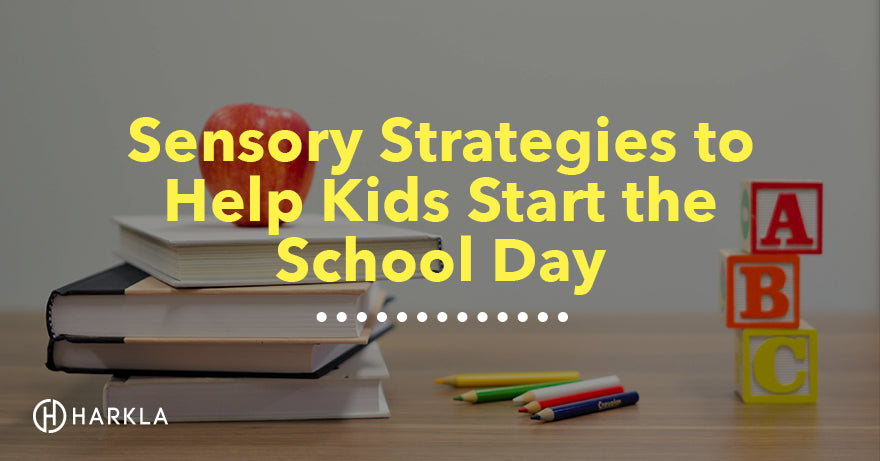Your Cart is Empty

Sensory Tips and Tricks to Get Your Kiddo Going in the Morning!
Does your child struggle to wake up in the morning? Do they have difficulty following their morning routine before school? Is the transition to school in the morning one of the hardest transitions of the day? If so, this article will give you some ideas as to WHY these challenges are occurring as well as some tips and tricks to help!
Many children struggle with the ability to transition from sleep to wakefulness. This is often referred to as “arousal level” and goes right along with self-regulation skills. In order for your child to successfully transition between sleep and wakefulness, they must alter their arousal level, or their state of alertness.
If your child did not get a good night’s sleep - maybe they struggle with falling asleep and/or staying asleep through the night - then their ability to move from sleep to wakefulness will be very difficult. Think about how you feel when you don’t get a good night’s sleep - waking up is definitely harder than when you get good rest! This is especially true for children, and can have even more negative effects on a child who additionally struggles with sensory processing.
If your child struggles with arousal level overall, then the task of waking up will be even more difficult. Maybe your child has a lower affect throughout the day, meaning they have a lower arousal level and may seem almost too calm or tired most of the time. Maybe they are a sensory avoider and prefer sedentary activities. Or perhaps your child has a higher affect throughout the day, meaning they have a higher arousal level and may seem hyper and very active most of the time. Maybe they are a sensory seeker and prefer to be on the move most of the time.
If your child struggles to achieve and maintain an expected arousal level for certain activities throughout the day - for example, they struggle to sit and remain calm for sit-down focus tasks because their energy level is too high - then they may struggle with the ability to move from sleep to wakefulness as well.
If this is the case, using some alerting strategies first thing in the morning can be helpful!
Helping your child achieve an alert state of arousal in the morning may take practice and consistency. You may need to alter or tweak the activities as your child gets older and they encounter different challenges at school. The key here: provide preferred alerting activities first thing in the morning in order to help move from sleep to wakefulness!
Maybe your child wakes up just fine (or you’re using some of the strategies above and they’re helping! Yay!) but they struggle to complete their morning routine. Maybe they don’t know what they need to do in the morning, or they lose things, or they’re too distracted. This can cause frustration not only for you - because you’re having to remind them constantly to do what needs to be done to get out the door on time - but also for them! Our children want to do well, so when they struggle, they may also feel frustration and anxiety!

If your child is struggling to follow their morning routine before school and they seem disorganized and/or distracted, it’s likely due to challenges with executive functioning skills. Executive functioning skills are a set of skills used to manage daily tasks. Things like impulse control, organization, initiation of task, memory, and attention are all part of executive functioning. If your child struggles in these areas, they will likely have difficulty following a routine, even if it’s a familiar, every day routine!
Let’s go through some ideas that can help improve your child’s success with moving through their before school morning routine:
For more ideas on how to help improve your child’s executive functioning skills, check out this YouTube video.
Some children experience real anxiety about going to school. This could be due to difficulty with self-regulation, challenges with social skills while at school, or overall anxiety throughout their day. If this is the case, your child may struggle to wake up and get going, they may struggle with their morning routine, and they may have difficulty leaving the house.
The following strategies may or may not be applicable to your child, so be sure to understand where your child’s anxiety is coming from first!
Getting a “good” breakfast in the morning can be very helpful for many children! Foods that include protein and fats are a great way to start the day, and decreasing the amount of processed sugar can help improve overall attention and focus for many children.
It’s also a great idea to incorporate as much sensory input as possible at breakfast! Provide foods with different textures - crunchy, soft, chewy - and different temperatures - cold, warm, hot. Try including a variety of flavor profiles as well - salty, savory, sweet, etc.

If your child isn’t a “breakfast person” and they don’t feel hungry in the morning, but you know they need something to get going, try a small smoothie and send them to school with a small morning snack. It can also be a good idea to make sure your child is drinking plenty of water first thing in the morning!
If your child is considered a picky eater and has a limited food rapport, before school might not be the best time to trial new foods. This can cause anxiety for many children who struggle with eating. Instead, provide them with familiar, comfortable foods that they don’t have to worry about as they get ready for a long day ahead!
Many children thrive with consistency and routine! Attempt to keep the morning, before school routine the same every day so your child knows what to expect. The first week or two may not be this way - the beginning of the school year typically comes with lots of change and can be seen as the “trial period” for your morning routine. Try different strategies, then stick with what works!
Children thrive with positive feedback. Therefore, if you can provide positive feedback throughout the morning, before school routine, your child is more likely to stick with the morning routine and head off to school with a positive mindset.
First, you’ll need to make sure YOU have a positive mindset! Your child feeds off of your emotions and if you feel stressed and anxious, they will too! Set yourself up with a successful morning routine that you use before your child wakes up in the morning. Pick 3 things you can do when you wake up that make you feel happy and calm and do them consistently before your child wakes up!
As your child goes through their morning routine, pick 3 things you can compliment them on. Try to keep it new every morning. If your child has been struggling with getting dressed and all of a sudden they have a small win with buttoning their pants, compliment them on their perseverance! If your child ate all of the breakfast, compliment them on sitting at the table for a full meal!
Some different verbiage to try:
Also work towards improving their ability to self-monitor and compliment themselves. Ask them questions about how they feel their morning went. Ask them what they think they did well with.
Remember that not every morning will be sunshine and roses! We all have rough mornings, and your child will too! If your child is having a rough morning, empathize and remind them that it happens to everyone!
Comments will be approved before showing up.


